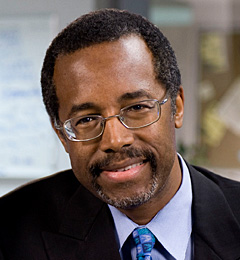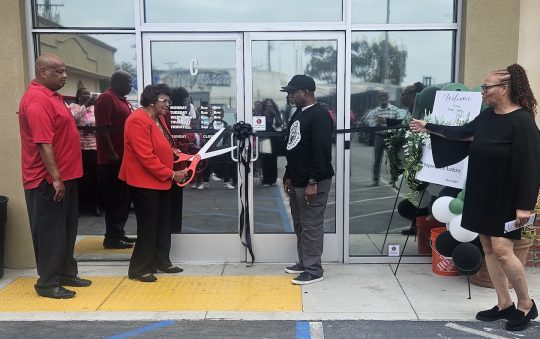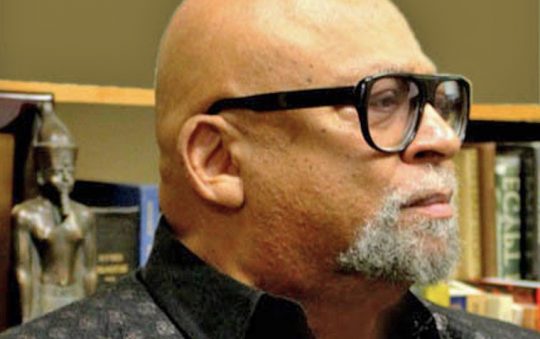
Dr. Benjamin Carson
.jpg)
Cuba Gooding as Dr. Carson and the real Dr. Ben Carson

Dr. Keith L. Black

Sidney Poitier, Dr. Black and Quincy Jones
*** Legends ***
By Yussuf J. Simmonds
Managing Editor
MEDICAL DOCTORS
Society is dependent on doctors to enhance the quality of human life on a daily basis. They serve the people, through caring, conducting research to produce medicines, combating diseases, and teaching, giving and sending others to continue their work extending the quality and the quantity of the human life. “Legends” is re-running the stories of Dr. Benjamin Carson and Dr. Keith Black; they are just a “small” sample of this exclusive club of medical practitioners.
DR. BENJAMIN CARSON
“Neurosurgeon with Gifted Hands that Heal”
Dr. Ben Carson is a hero like no other; he inspires and motivates others to excel by using their natural talents. He was born Benjamin Carson, the younger of two children, and was raised by his mother, Sonya Carson. His mother and father were divorced when young Benjamin was just eight years old and that placed a heavy burden on his mother, who only had a third-grade education. Though Carson and his brother, Curtis lived in the bowels of extreme poverty, their mother was very determined to guide them out of that condition. Young Benjamin was an average student, with poor grades and an uncontrollable temper. However, he did get through elementary school and improved in high school, scoring high enough to achieve scholarship status that sent him to medical school.
During those years his mother worked long and hard as a domestic worker to provide her sons with what they needed. Since her work usually took her to wealthy people’s homes, she was determined that her sons work benefit from her observations of the wealthy; she would also work two, and sometimes three jobs. (Later on in life, Carson would detail her trials and tribulations in his autobiography). Sonya Carson wanted his son to be a doctor, and he in turn wanted to be a missionary doctor. She deprived herself of the meager excesses she was barely able to afford and made some Spartan sacrifices included home tutoring, controlled television viewing, an array of extra-curricular activities to advance her children’s future–especially young Benjamin’s.
Though his grades were lagging, his mother’s intervention and monitoring soon began to produce more acceptable results. She placed the brothers, Benjamin and Curtis on a strict regimen of reading and various other academic activities, designed to bolster their sagging grades. It worked, and within a year, Carson was at the head of his class. His mother’s parental persuasion had taken hold of him and his hunger for knowledge became second natured; he would amaze his classmates and his teacher(s) with his newfound brilliance which he shrugged off casually. Much to her dismay, Sonya Carson, because of her lack of education, was barely able to read and was unable to participate in her children’s academic work. But she compensated for that with her motivation, and discipline when needed.
Carson received his Bachelors degree in psychology at Yale University and his medical degree from the University of Michigan School of Medicine at Ann Arbor. His internship in general surgery and his residency were done at John Hopkins Hospital in Baltimore, Maryland. Since then, his practice has taken him to many corners of the world. He has touched people from Germany, South Africa and has been in residency at the Sir Charles Gardner Hospital and Queen Elizabeth Medical Center in Western Australia.
Carson specialized in the pediatric neurosurgery and at age 32, he was appointed the director of the pediatric neurosurgery at John Hopkins Hospital. One of his famous surgeries is the separation of a pair of Siamese twins. They were born, joined at the back of the head, and generally such delicate operations had a zero rate of success–usually one or both infants would die. The prognosis was that the twins shared a section of the skull, skin tissue and one of the major veins responsible for allowing blood from the brain to the heart. Carson undertook the operation with 70-member surgical team, and after reportedly working for 22 hours; he successfully separated the twins, allowing them to survive physically independent of each other.
His other surgical breakthroughs include the first intra-uterine procedure to relieve pressure from the brain of a hydrocephalic twin during the advanced stages of conception. And the removal of half of an infant’s brain due to uncontrollable seizures by a procedure called hemispherectomy, thereby allowing the infant to utilize the other half of his brain in a compensatory way.
Despite the rigors of Carson’s schedule, he still finds time to impart his knowledge of neurosurgery to others and to participate in many other academic activities. He is professor of Neurosurgery, Oncology, Plastic Surgery and Pediatrics at the John Hopkins University School of Medicine; and the co-director of the John Hopkins Craniofacial Center. He is a member of the Board of Neurological Surgery, the Pediatric Neurological Surgery, the Kellogg Company and the Yale Corporation, the latter being the governing body of Yale University. In 1997, Carson took a leave of absence from his medical duties to tour the country speaking and motivating groups of young people. He has authored over 90 neurological publications, and has written three best selling books: “Gifted Hands,” “Think Big” and “The Big Picture.”
“Gifted Hands” is Carson’s story of his childhood struggles, being raised by a single mother, overcoming his under-achieving grade level status and becoming an A-plus student. He scripted his travels from the ghettos of Detroit to becoming the director of pediatric neurosurgery at John Hopkins University Hospital, and how his motivational source came primarily from his mother. In “Think Big”, he outlines the importance of education in achieving one’s goals and aspirations in life and how the pursuit of excellence can produce the fullness of one’s power and potential. And in “The Big Picture” he shows how his faith and vision were able to carry him through some rough times and produce what he eventually became–a master surgeon. He also reveals his philosophy and spiritual perspectives, and how they relate to his life, and his personal experiences with racial diversity, healthcare and education.
“Gifted Hands: the Ben Carson Story” was a movie about Carson played by academy award winner, Cuba Gooding. Critics said that no one else comes to mind for playing Carson with the passion he projects than Gooding. Torn between his loyalty to his skills as a surgeon, and a lack of faith in himself, are what made this film all the more realistic–very emotional & inspiring film!
Carson is married to Candy and they work together to keep his vision a reality.
To complement, his books and his lectures, Carson has also produced videos of his words and through his works. In addition, Carson and his wife, Candy, have set up the Carson Scholars Fund–in Maryland, Delaware, Washington, D.C., and other states throughout the country–to recognize and reward students who strive for academic excellence. He has also implemented the Carson Reading Rooms that have become studying oases among designated school’s classrooms. He is truly a role model for all.
DR. KEITH L. BLACK
“Art is a discipline that is practiced with passion and science is a passion that is practiced with discipline”
The above words are a quote from Dr. Keith Lanier Black, who at 40, is one of the foremost neurosurgeons in the United States. He is the director of the Cedars-Sinai Neurological Institute after having been the head of Comprehensive Brain Tumor Program at the Medical Center in Los Angeles.
It may be remembered that in the movie “Guess Who’s Coming to Dinner,” Sidney Poitier played the role of a “super” doctor, Dr. John Wade Prentice. When the father of his intended bride checked out his credentials, he found out that the man he referred to as a ‘negro’ was a ‘super doctor.’ In the real world, Dr. Keith Lanier Black is the real Mc coy–a stellar, real live version of Poitier’s Dr. Prentice, and beyond. But not only is Black a famous neurosurgeon, he is a leading researcher specializing in brain cancer, and has published over 100 scientific papers. However, this does not preclude him from maintaining an active role in community affairs; he finds time to work with and inspire young people, and campaigns tirelessly for funding for cancer treatment.
He is intensely focused on helping others. For example, according to medical data, he usually performs approximately 250 brain surgeries a year, whereas most neurosurgeons perform about 15 during the same period. A list of Black’s patients illustrates the depth and the quality of his work. Famed attorney, Johnnie L. Cochran was one of his patients. (It was a unique setting–the super doctor taking care of the super lawyer). Patients from all over the world still come to see Black after they’ve been told there is no hope; and he usually gives them the hope that was elusive in other practitioners.
During an interview Black was asked, “What is it like standing in the operating room with someone’s brain exposed in front of you in a life or death situation?”
He responded thus, “You get into an entirely different zone. There’s something extra that allows one to find a safe corridor, to sneak into the human brain in a way that the brain never realized you have been there.”
Black’s cutting-edge research has led to the development of a delivery method for administering chemotherapeutic drugs directly to the tumor, and the creation of vaccines to enhance the body’s immune response. It’s an innovative treatment that’s buying valuable time for cancer patients, something that most of them have in short supply. It’s also a combo of vaccines and chemotherapy that medical observers compare to be as close as humanly possible to be able to look at “God’s art,” the doctor’s descriptive term for the mysterious and beautiful human brain.
But there are consequential drawbacks in many scientific fields of endeavor, and as Black has so skillfully defined and compared his profession to art as “a discipline that is practiced with passion, and to science as a passion that is practiced with discipline.” To that end, he has consumed his research efforts to minimize the medical deficiencies that are obvious and apparent with the most important part of the human body–the brain. Furthermore, he adds, “I could not think of a diagnosis that is more devastating than the diagnosis of a brain tumor.”
One of the medical discoveries that Black is best known for is a peptide occurring naturally in the body which was highly effective in opening the blood-brain barrier by causing capillary walls to be leaky, called ‘bradykinin.’ This creates a protective maze of blood vessels that slow the progress of medication traveling from the blood stream to brain tissue. To accomplish his findings, Black had to investigate other natural body compounds that induced swelling after injury and also made blood vessels leaky. In his conclusion Black explained, “The fantastic thing about ‘bradykinin’ is that it does not open the barrier to the normal brain–only to tumors.” He patented his method of selective opening of abnormal brain tissue capillaries.
Another innovative method based on his research is geared towards strengthening the body’s own immune response. It involved extracting the tumor cells during surgery; genetically modifying the culture cells; culturing the cells in the laboratory; and injecting the genetically engineered product into a patient as a vaccine.
Black was born in Tuskegee, Alabama, on September 13, 1957, the younger of two sons born to Robert and Lillian Black. At an early age his parents noted his interest in science and they encouraged him. After moving to Ohio, young Black began spending an inordinate amount of time at Case Western University. To help nurture his passion for science, his father once reportedly brought home a cow’s heart for him to dissect. By the age of seventeen, he had developed the surgical ability to perform an organ transplant on a dog, and had written a scientific paper on the effects artificial heart valve damage on red blood cells.
After high school, Black attended the University of Michigan, where he did his undergraduate studies and also earned his medical degree in 1981. His immediate focus turned to research into the brain and human consciousness combined with a study of the world’s religions which led him to his career mission to cure brain tumors. He did his internship in general surgery and his residency in neurological surgery at University of Michigan Medical Center at Ann Arbor.
He served on the faculty of the University of California, Los Angeles (UCLA) for 10 years where he was awarded the Ruth and Raymond Strotter Chair in 1992, and was head of UCLA Comprehensive Brain Tumor Program. From there he went to Cedar-Sinai Medical Center, where he remains as head of the Comprehensive Brain Tumor Program and has been the director of the Maxine Dunitz Neurosurgical Institute.
The institute is dedicated to advancing the field of neurosurgery, providing leading-edge, compassionate clinical care and conducting unparallel research for a full range of neurosurgical conditions. Under Black’s direction the institute offers both children and adults medical, surgical and neuro-oncologic care a wide range of conditions including: achondroplasia, brain aneurysm, epilepsy, spinal deformities and tethered cord. And many of the procedures are done using minimally invasive neurosurgery techniques.
Black has been featured on the cover of a “Time” magazine special edition “Heroes of Medicine”; he was profiled on the PBS program, “the New Explorers” called “Outsmarting the Brain”; he was in the “Newsweek International”; he received the Essence Award; and was named “Esquire” magazine’s one of the “21 most important people of the 21st century.
Black serves on the boards of the Neurological Research, Gene Therapy and Molecular Biology, Neurosurgery Quarterly and Frontiers in Bioscience. He is a member of numerous professional societies, including the American Association of Neurological Surgeons, Neurological Society of America, the Academy of Neurological Surgery, and is also a founding member of the North American Skull Base Society.
A devoted family man, he generally reserves his weekends for his wife, Dr. Carol Bennett, and their children, Keith, Jr. and Teal.






